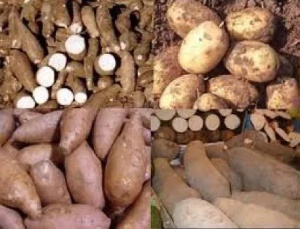Her worry was not only how drastically she reduced the prices of her watermelon to be able to sell fast, but the fear of rapid deterioration even at the low price as she towed the fruits around the market square.
Asana Amadu, a farmer in Bawku in the Upper East Region became worried as the income and proceeds from the sales will not be able to settle debts she owed the village input supplier.
As she steps and walks over the remaining rotten produce hailed by flies, her pride as a watermelon farmer waned.
Fruit farming in Ghana as well as the production of staple foods such as maize, millet, cowpea, groundnuts and tomatoes suffer challenges of post- harvests losses.
Mr Emmanuel Woolingdool, the Policy Officer of the Ghana Trade and Livelihoods Coalition (GTLC) in an interview with the Ghana News Agency the perishable nature of tomatoes and especially the way it was transported from the farms to the markets, packed in trucks under the scorching sun for two or three days, left much to be desired.
He noted that post- harvest losses in tomatoes contributed to loss of income of market women and farmers because the old system of packing exposed the produce to the weather.
Agriculture contributes substantially to the economic growth of Ghana and employs about 40% of the total population of the country. While agricultural productivity has traditionally and increasingly received greater attention, the reduction of post-harvest food losses is a critical complementary means of increasing food availability.
The cost of preventing food losses is in general less than the cost of producing a similar additional amount of food of the same quality.
Though agriculture remains the largest employment sector, for many farmers like Ms Amadu, post-harvest losses would continue to plague them.
When farmers are unable to store produce after harvest, they are obliged to sell it immediately after the harvest at low prices, thereby unable to make profit and in some cases incur heavy losses that contribute to poverty.
Limited processing facilities further worsen the plight of watermelon farmers and other crop farmers. They continue to use the traditional methods of storage including the use of ash and sand.
However, it is estimated that farmers lose about 56 per cent of their harvested produce from the farm gates because of how they are dried and stored.
For maize, some few warehouses are available to support farmers with storage facilities through Public Private Partnership, such as WIENCO, Suppliers of Fertilisers, but they are only dotted in specific areas with a few farmers benefiting.
Generally beyond the loss in quantity, there is also loss in quality, forcing communities not to patronise the damaged grains destroyed by insects, worms, parasites and birds.
Xxxx (Which source is this statement) Yields of most crops over the years are generally low and have remained almost constant between 2002 and 2016.
Agricultural productivity has generally been low principally due to the over reliance on erratic rainfall, and low-performing irrigated systems; low level of mechanisation, and high post-harvest losses that make agriculture unprofitable and unattractive to the youth.
Xxxx (Official source) Food insufficiency resulting from post- harvest losses affect most communities in Ghana and the annual impact leads to poor diet and malnutrition.
Post- harvest loss in groundnuts cannot be underestimated. According to experts, aflatoxins contamination in groundnuts, cause health risks though in many instances the produce serve as a major food complement especially in the northern part of the country for children and adults. A huge loss culminates from poor germination, poor harvesting and poor storage leading to the development of fungi and toxins with high exposure to unsafe food consumption.
Therefore the problem of post harvest losses need to be given serious attention if nutrition, particularly reducing stunting, which affects 19 per cent of children under five years, is to be addressed.
The fact that families have to bear the rising cost of food prices in the market when harvest is low put the vulnerable farmers and the entire population at risk.
Xxx Ghana is said to lose about 20 to 50 per cent of all vegetables, fruits, cereals, roots and tubers produced each year, after harvest. In the Upper East Region alone 13, 000 tonnes of maize was lost in 2016 according to experts. (Can you name some of them to make the story solid?)
Though Ghana is doing well towards zero tolerance for hunger by 2030, these gains will be short lived if attention is not placed on promoting Sustainable Agriculture and addressing post- harvest loss. Policy makers need to put more emphasis on addressing the issue to ensure food sufficiency.
Xxxx (According to which source) As the world’s food requirement is expected to increase by 70 per cent in 2050, in anticipation to feed an estimated 9 billion projected population, farmers need to be equipped with the necessary skills to be able to produce to meet demand.
It is when farmers have enough to sell and make profits that they can provide other needs for the family.
From the Agro Policy Performance Barometer (APPB) report 2016 , a flagship report of the Ghana Trade and Livelihood Coalition (GTLC), an assessment of the Medium Term Agriculture sector plan (METASIP) implementation raised concerns that government agencies including the Ministry of Food and Agriculture (MOFA) that have the mandate to ensure good return on investments, increased food security and job creation as a reflection of Ghana’s Food Policy to be doing very minimal in terms of investments in the Agricultural sector to reduce post- harvest losses.
The report showed low investments in the sector in addressing the challenges of food production and indicated that though a budget of GHc355.14 million was earmarked in 2016 for the agricultural sector, the actual expenditure was GHc 181.29 million. Of that amount, GHc164.24 million was spent on poverty focused expenditures such as fertilizer subsidy programme and the establishment of Agricultural Mechanization service centres to boost production.
The low productivity in the agriculture sector has major implications for food and nutrition security in the country. The METASIP , (2011–2015), also indicated that the country continued to experience deficits with regard to rice, maize, sorghum, and millet availability, resulting in the need for food import to make up for the cereal production shortfall.
Due to these looming problems, SNV, a Netherlands Development Organisation and a non-profit, international development organisation and its partners are implementing a programme dubbed “Voice for Chanage (V4C) partnership Programme.
One of its components seeks to increase food and nutrition security and incomes of smallholder farmers, especially women through a sustained engagement with government and the private sector to improve service delivery and increase investment in post-harvest management.
It is for this reason that the Municipal and District Assemblies need to critically consider post harvest losses in the context of the whole agricultural value chain from the farm gate, farm centres and communities and storage.
To sum up, Mr Woolingdool said training farmers in the right application of chemicals, observation of proper farm sanitation and drying techniques are critical in addition to ensuring good roads to the farm gates.
Business News of Saturday, 21 October 2017
Source: ghananewsagency.org

















